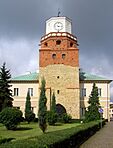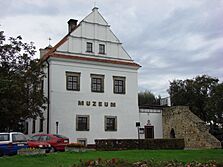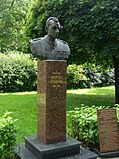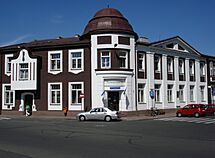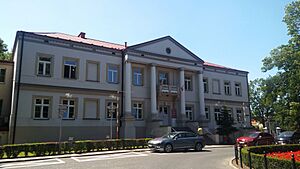Wieluń facts for kids
Quick facts for kids
Wieluń
|
|||
|---|---|---|---|
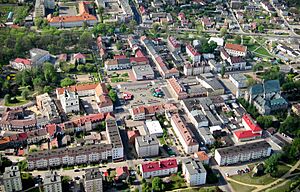
Old town in Wieluń
|
|||
|
|||
| Country | |||
| Voivodeship | |||
| County | |||
| Gmina | |||
| First mentioned | 1282 | ||
| Town rights | 1283 | ||
| Area | |||
| • Total | 16.9 km2 (6.5 sq mi) | ||
| Population
(31 December 2021)
|
|||
| • Total | 21,624 |
||
| Time zone | UTC+1 (CET) | ||
| • Summer (DST) | UTC+2 (CEST) | ||
| Postal code |
98–300
|
||
| Area code(s) | +48 43 | ||
| Car plates | EWI | ||
| Website | http://www.wielun.eu/ | ||
Wieluń is a town in south-central Poland with about 21,600 people living there (as of 2021). It's the main town of the Gmina Wieluń and Wieluń County, and it's located in the Łódź Voivodeship region. Wieluń is also known as the capital of the historic Wieluń Land.
Wieluń has a very long and interesting history. In the past, it was an important trading center in the Kingdom of Poland. Many Polish kings and important people visited the town. However, after a terrible event called the Swedish Deluge (1655–1660), Wieluń became less important. In September 1939, during the start of World War II, the town was heavily bombed by German planes. This event, known as the Bombing of Wieluń, is considered the first bombing of World War II in Europe. It sadly killed at least 127 people and destroyed most of the town.
Contents
What's in a Name?
Wieluń was first mentioned in old papers in 1282, called "Velun." The exact meaning of its name isn't fully clear. Some historians think it comes from a Slavic word "vel," which means a wet or marshy area. Others believe it comes from a name like "Wielisław." An old writer, Jan Długosz, said that Wieluń was in an area with lots of water, which might support the idea that the name comes from "wetland."
Wieluń's Past
Early History
The Land of Wieluń was a historic area in the Kingdom of Poland. For many centuries, it was part of the Sieradz Voivodeship, which was a region within the larger Greater Poland Province.
This area started as a medieval Castellany (a type of administrative district) in a place called Ruda, about 4 kilometers from Wieluń. It was set up around the 10th or 11th century. Ruda was important because it had a castellan (a local ruler) and a church leader, making it a center for local government. But by the mid-13th century, Wieluń became more important because it was in a better location. In 1281, the castellan's office moved to Wieluń, and soon after, the area became known as the Land of Wieluń instead of the Land of Ruda.
The town of Wieluń was likely founded around 1220 by Duke Władysław Odonic. It was first mentioned in documents in 1282, and it probably received its town rights in the same year. In the mid-1300s, King Casimir III the Great built a castle here. This castle was part of a defense system to protect the border between the Kingdom of Poland and Silesia, which was ruled by the Czechs. The castle was rebuilt many times because of fires and wars. Today, a Classicistic palace stands where the castle used to be.
In both the Kingdom of Poland and later the Polish–Lithuanian Commonwealth, the Land of Wieluń had its own officials, offices, and courts. The Castellan of Wieluń was one of the important Senators of Poland. The area also had four local administrators called starostas. People from Wieluń also elected two representatives to the Polish parliament, called the Sejm.

In 1370, King Louis I of Hungary gave the Land of Wieluń to Duke Władysław Opolczyk. Around the same time, the Archbishop of Gniezno built a manor house in Wieluń. The town stayed with Władysław Opolczyk until 1395, when it became part of Poland again. Wieluń grew quickly. In the 1390s, a church and a monastery were built. By the 1400s, Wieluń was an important center for trade and government.
The Land of Wieluń even had its own coat of arms, created between 1410 and 1434. You can see it on the tomb of King Władysław II Jagiełło, alongside the coats of arms of other important regions.
Later Times
Wieluń was very successful in the 16th century, which is known as the Polish Golden Age. It was a royal city and the capital of the Land of Wieluń. At the beginning of the 17th century, the mother of a famous Polish commander, Stanisław Koniecpolski, built a beautiful monastery in Wieluń. Today, this building is a museum about the town's history.
Good times for Wieluń ended during the terrible Swedish invasion (1655–1660). The town was robbed and burned by both the Swedish invaders and even some Polish troops. Then, from 1707 to 1711, a plague killed 2,000 people in Wieluń.
After the Second Partition of Poland in 1793, Wieluń briefly belonged to Prussia. In 1807, it became part of the Polish Duchy of Warsaw, and in 1815, it was taken over by Russia. The town burned down twice more (in 1791 and 1858). After the second fire, it was rebuilt with a new layout. After World War I, Poland became independent again in 1918, and Wieluń became a county seat in the Łódź Voivodeship.
World War II
On September 1, 1939, German planes bombed Wieluń. This was one of the very first actions of World War II. In this attack, German planes destroyed most of the town center, including a hospital (which was clearly marked), a synagogue, and a historic church. At least 127 people were killed, and many more were hurt. According to historian Norman Davies, three-quarters of the town was destroyed.
After the bombing, Wieluń was taken over by Nazi Germany on October 8, 1939. The Germans started to treat the Jewish people of Wieluń very badly. Jewish people had lived there since the 1500s, and there were about 4,000 of them at the start of the war. They were forced to work for very little pay.
In June 1940, the Germans forced about 200 Polish families to leave their homes, which were then given to German officials. During the German occupation, a camp was set up in Wieluń for Poles who were forced out of their homes in the region. They were then sent to other parts of German-occupied Poland or forced to work in Germany. The Germans also had a prison in the town and stole valuable historical coin collections.
In 1941, Jewish people were forced to live in a special area called a ghetto. Many were then sent to labor camps. Later that year, about 2,000 Jewish people were gathered and held in a church building for several days without food or water. Many died there. Some were sent to the Łódź ghetto, and others were sent to the Chełmno extermination camp. Only about 70 to 100 Jewish people from Wieluń survived the war.
The city was freed on January 19, 1945, by Soviet troops.
Climate
Wieluń has a climate that is similar to many parts of Central Europe. It has warm summers and cold winters.
| Climate data for Wieluń (1991–2020 normals, extremes 1951–present) | |||||||||||||
|---|---|---|---|---|---|---|---|---|---|---|---|---|---|
| Month | Jan | Feb | Mar | Apr | May | Jun | Jul | Aug | Sep | Oct | Nov | Dec | Year |
| Record high °C (°F) | 13.8 (56.8) |
18.0 (64.4) |
23.8 (74.8) |
29.5 (85.1) |
31.7 (89.1) |
36.4 (97.5) |
36.4 (97.5) |
37.1 (98.8) |
34.8 (94.6) |
26.3 (79.3) |
19.9 (67.8) |
15.2 (59.4) |
37.1 (98.8) |
| Mean daily maximum °C (°F) | 1.7 (35.1) |
3.3 (37.9) |
7.9 (46.2) |
14.7 (58.5) |
19.5 (67.1) |
22.8 (73.0) |
25.1 (77.2) |
24.9 (76.8) |
19.4 (66.9) |
13.4 (56.1) |
7.4 (45.3) |
2.7 (36.9) |
13.6 (56.5) |
| Daily mean °C (°F) | −1.0 (30.2) |
0.1 (32.2) |
3.5 (38.3) |
9.2 (48.6) |
13.9 (57.0) |
17.2 (63.0) |
19.3 (66.7) |
19.0 (66.2) |
14.2 (57.6) |
9.1 (48.4) |
4.3 (39.7) |
0.3 (32.5) |
9.1 (48.4) |
| Mean daily minimum °C (°F) | −3.4 (25.9) |
−2.7 (27.1) |
0.1 (32.2) |
4.2 (39.6) |
8.7 (47.7) |
12.0 (53.6) |
13.9 (57.0) |
13.8 (56.8) |
9.8 (49.6) |
5.7 (42.3) |
1.9 (35.4) |
−1.9 (28.6) |
5.2 (41.4) |
| Record low °C (°F) | −29.0 (−20.2) |
−28.0 (−18.4) |
−19.4 (−2.9) |
−7.0 (19.4) |
−2.4 (27.7) |
−1.6 (29.1) |
4.1 (39.4) |
2.4 (36.3) |
−2.9 (26.8) |
−7.7 (18.1) |
−17.3 (0.9) |
−25.3 (−13.5) |
−29.0 (−20.2) |
| Average precipitation mm (inches) | 33.8 (1.33) |
30.9 (1.22) |
37.0 (1.46) |
35.8 (1.41) |
69.6 (2.74) |
70.3 (2.77) |
90.7 (3.57) |
51.5 (2.03) |
51.2 (2.02) |
42.0 (1.65) |
37.9 (1.49) |
36.9 (1.45) |
587.6 (23.13) |
| Average extreme snow depth cm (inches) | 6.7 (2.6) |
6.0 (2.4) |
4.1 (1.6) |
1.2 (0.5) |
0.0 (0.0) |
0.0 (0.0) |
0.0 (0.0) |
0.0 (0.0) |
0.0 (0.0) |
0.5 (0.2) |
1.7 (0.7) |
3.6 (1.4) |
6.7 (2.6) |
| Average precipitation days (≥ 0.1 mm) | 16.81 | 14.57 | 14.27 | 11.70 | 13.33 | 14.17 | 14.17 | 12.43 | 11.83 | 13.63 | 13.70 | 16.27 | 166.88 |
| Average snowy days (≥ 0 cm) | 14.9 | 13.6 | 6.1 | 0.9 | 0.0 | 0.0 | 0.0 | 0.0 | 0.0 | 0.3 | 3.1 | 9.6 | 48.5 |
| Average relative humidity (%) | 85.9 | 83.0 | 76.9 | 68.5 | 70.5 | 71.4 | 70.4 | 70.1 | 76.6 | 82.4 | 86.9 | 87.4 | 76.1 |
| Mean monthly sunshine hours | 51.1 | 69.6 | 123.5 | 188.9 | 240.7 | 234.7 | 245.4 | 232.4 | 163.8 | 114.9 | 58.0 | 43.3 | 1,766.2 |
| Source 1: Institute of Meteorology and Water Management | |||||||||||||
| Source 2: Meteomodel.pl (records, relative humidity 1991–2020) | |||||||||||||
Places to See
Wieluń has many interesting historical places. These include the Town Hall, old defensive town walls from the Middle Ages, a former school building, and several historic churches. Some of these churches are the Gothic Corpus Christi Collegiate church and the beautiful Baroque churches of Saint Joseph and the Annunciation of Mary.
The Museum of Wieluń Land is the main museum in town. It's located in a Renaissance-style monastery. The museum tells the story of Wieluń and the area around it. It has collections of old artifacts, items from daily life, historical documents, and art. You can see ancient jewelry and weapons from the Bronze Age, as well as items from Polish uprisings in the 1800s. There's also an exhibition about the German bombing of Wieluń at the start of World War II.
You can also find monuments in Wieluń dedicated to important people like Witold Pilecki and Pope John Paul II. There are also several memorials from World War II, honoring those who died in the 1939 bombing and the local Jewish people who were killed during the Holocaust.
Population
Most people living in Wieluń are Catholic.
Here's how the number of people living in Wieluń has changed over the years:
- 1900: 7,361 people
- 1909: 9,095 people (including 3,444 Jewish people and 352 Protestants)
- 1931: 13,220 people
- 2006: 24,347 people
Getting Around
Roads
Wieluń is an important place for roads. Main roads connect Wieluń to Warsaw (to the north-east) and Wrocław (to the west). There are also two national roads: number Invalid type: DK to Częstochowa and number Invalid type: DK to Opole and Łódź.
Two local roads also start from Wieluń: road number 481 goes north-east to Łask, and road number 486 goes south-east to Radomsko.
One challenge in Wieluń is the heavy traffic in the town center because there aren't enough bypasses (roads that go around the town). A bypass for National Road Invalid type: DK was finished in March 2017. More bypasses are planned for the future. There's also a major expressway, S8, located near the northern edge of the town.
Railways
Wieluń has train connections to cities like Poznań and Katowice. The railway line was built in the 1920s. It was very important back then because it connected Polish areas when a direct route was not possible. After World War II, it became less important.
Until the late 1980s, there was also a narrow-gauge railroad that connected Wieluń with nearby Praszka. Today, the town has two train stations: Wieluń Dąbrowa and Wieluń Miasto. You can travel by train directly from Wieluń to cities like Tarnowskie Góry, Katowice, Poznań, Szczecin, and Kępno.
Buses are another way to travel around Wieluń and to other parts of the country. The town has a modern bus station built in 1976, which also handles international bus routes.
Local Buses
Wieluń has its own local bus system, just like most cities. There are 8 bus lines operated by a local transport company, PKS Wieluń. Public transportation in Wieluń has been running since 1988.
- Line A: Wieluń-Dąbrowa Railway Station – Rychłowice
- Line B: Gas bottling plant – Ruda
- Line C: Wieluń-Dąbrowa Railway Station – Olewin
- Line D: Kurów – Wierzchlas
- Line D – BIS: Wieluń-Dąbrowa Railway Station – POW street
- Line E: Gas bottling plant – Stare Sady housing estate
- Line G: Gas bottling plant – Częstochowska street
- Line H: Masłowice – Stare Sady housing estate
Sports
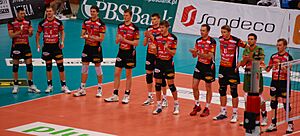
The town has a sports club called WKS Wieluń, which started in 1957. In the past, WKS Wieluń had teams for many sports, including track and field, basketball, table tennis, handball, and association football. Today, only the football team remains.
Another notable sports club is Siatkarz Wieluń, a volleyball team. They play in lower leagues now, but in the past, they played in the PlusLiga, which is Poland's top volleyball league.
Famous People from Wieluń
- Teresa Janina Kierocińska (1885–1946), a nun.
- Piotr Paweł Morta (born 1959), a political activist and economist.
- Jan Wątroba (born 1953), a bishop in the Roman Catholic Church.
- Mariusz Wlazły (born 1983), a volleyball player and World Champion.
Town Areas
Wieluń is divided into several areas, including:
- Downtown
- Armii Krajowej housing estate
- Bugaj housing estate
- Kopernika housing estate
- Stare Sady housing estate ("Old Orchards" housing estate)
- Wyszyńskiego housing estate
- Wojska Polskiego housing estate
- "Za szpitalem" (Behind Hospital housing estate)
- Niedzielsko
- Chrusty
- Berlinek
- Stodolniana housing estate
- Moniuszki housing estate
- Podszubienice
- Kijak
- Błonie
International Friends
Wieluń has "twin town" relationships with other cities, which means they share cultural and friendly ties.
 Adelebsen, Germany
Adelebsen, Germany Osterburg, Germany
Osterburg, Germany Ochtrup, Germany
Ochtrup, Germany
See also
 In Spanish: Wieluń para niños
In Spanish: Wieluń para niños









